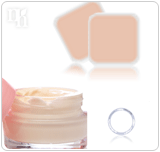
Since the 1940s, estrogen hormones have been a common supplement for treating menopausal symptoms such as hot flashes. Estrogen hormones have also been used to prevent chronic diseases such as cardiovascular disease and osteoporosis. Since 2002 the use of estrogen hormones has decreased following a study by the Women's Health Initiative (WHI), showing that women using conjugated equine estrogen hormones (CEE) and medroxyprogesterone acetate were at greater risk of coronary heart disease, strokes, and breast cancer than women taking placebo. Due to the fact that the Women's Health Initiative indicated that estrogen hormones were unsafe for preventing disease, recommendations for postmenopausal hormone therapy have been altered. Though, low-dose estrogen hormones use for treating menopausal symptoms is still approved. The review detailed below aimed to compare the effectiveness and safety of the most popular estrogen hormones preparations used to relieve menopausal hot flashes.
Following findings from the WHI, The US Food and Drug Administration recently pushed for estrogen hormones safety advice to be included on products and altered approved indications for its use. Package information says that treating hot flashes and other menopausal symptoms is one possible use for estrogen hormones but today doctors are advised to use the smallest viable dose for the shortest time period possible.
There are various estrogen hormones preparations available for easing hot flashes, such as oral, transdermal, and topical forms. A comparison of different estrogen hormones agents to relieve hot flashes is needed due to concerns about CEE pointed out in the WHI study. Disparities between agents and routes have been highlighted but it is uncertain whether or not such differences result in significant clinical effects.
In terms of measuring hot flashes in the estrogen hormones trials, females were usually asked to make note of the number hot flashes occurring over a daily or weekly basis, and changes denoted treatment responses.
estrogen oral

Findings from the trials included in this evaluation suggest that CEE and oral and transdermal 17 -estradiol are more successful than placebo in alleviating menopausal hot flashes, and findings do not show that one is more effective than another. Varying doses can be effective, but a dose-response connection was reported in a few investigations. Not many trials have focused on estrogen hormones other than CEE and 17 -estradiol, so it is not possible to determine their comparative success.
Such findings are in keeping with a Cochrane review and meta-analysis of trials of oral estrogen hormones compared with placebo for relieving menopausal hot flashes, published prior to 2000. Data suggested a 77% reduction in regularity and a considerable decline in severity of hot flashes with oral estrogen hormones compared with placebo.
Only a handful of trials have focused on estrogen hormones other than CEE and 17 -estradiol and so it is difficult to assess the success of various estrogen hormones is treating menopause symptoms such as hot flashes. What the findings above do show is that CEE and oral and transdermal 17 -estradiol have consistent effects on treating menopausal symptoms but may also cause side effects. It can be concluded that further exploration is needed; for example effects on a larger demographic sample of women, longer follow-up, more patients, and more head-to-head comparisons of estrogen hormones, progestins or progesterones, and other therapies. This extra research would lead to better information about personal estrogen hormones use for treating hot flashes, including which women would benefit from estrogen hormones use and any potential side effects.